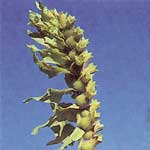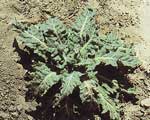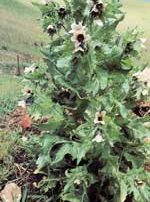Black Henbane
Hyoscyamus niger L.
Keys to Identification
- Black Henbane, a member of the nightshade family, may be an annual or biennial and grows from 1 to 3 feet tall. The leaves are coarsely-toothed to shallowly lobed and pubescent. Flower, blooming along the long racemes, are brownish-yellow with a purple center and purple; veins. The plant has a foul odor.
- Black Henbane is a native of Europe and has been cultivated as an ornamental. It has spread throughout the United States and is a common weed of pastures, fence rows, roadsides, and waste areas. Black Henbane contains hyoscyamine and other alkaloids which can cause livestock poisoning. It is considered a poisonous plant to humans.
This information courtesy of the Colorado Natural Areas Program
Family
Solanaceae (Nightshade)
Other Names
Insane root, Stinking Nightshade, Fetid Nightshade, Hog’s Beam
USDA Code
HYNI
Legal Status
Colorado Noxious Weed List B
Identification
Lifecycle
Biennial forb
Growth form
Forb
Flower
lowers are brownish-yellow with dark purple veins. On long racemes (unbranched group of flowers where the newr flowers grow at the tip) in the axils (where the leaf stalk meates the stem) of the upper leaves. June to September.
Seeds/Fruit
Fruits are approximately 1 in long, five-lobed, and clustered on 2 rows that emerge in the fall. Each fruit capsule contains hundreds of tiny seeds. Seeds are kidney-shaped to oval, brownish-gray to black, and pitted.
Leaves
Leaves are alternate, coarsely toothed to shallowly lobed and pubescent (hairy) with a characteristically foul odor (Whitson et al. 1996).
Stems
Mature plants are coarse, hairy, and 1-3 feet tall.
Roots
No information available.
Seedling
The large rosettes have serrated leaves that are covered with fine hair.
Other
Foliage has a pungent, foul odor at all growth stages.
Impacts
Agricultural
Black henbane is poisonous to livestock. However, because of the foul odor of the plant, livestock will seldom graze it, and few cases of livestock poisonings have been reported (Haderlie et al. 1991).
Ecological
Black henbane usually establishes on disturbed or heavily grazed sites where it competes for moisture and nutrients with desirable plants.
Human
All parts of the plant are potentially poisonous.
Habitat and Distribution
General requirements
Black henbane is commonly found in pastures, fence rows, roadsides, waste places, and riparian areas. It does well in most soils, and will grow in a variety of environmental conditions. Black henbane growth is enhanced by increased levels of soil nitrogen (Haderlie et al. 1991).
Distribution
Black henbane is established on the Front Range along lower Boulder Creek (Weber 1976), and is also found on the West Slope (A. Green, pers. comm.). Black henbane has spread throughout the United States, especially in the Northeast, Midwest, and Rocky Mountains (Haderlie et al. 1991).
Historical
Medicinal uses of black henbane date back to the 10th century (Haderlie et al. 1991). It has been used as a sedative and narcotic in cases of maniacal excitement, sleeplessness, nervous depressions, and various other ailments (Haderlie et al. 1991).
Biology/Ecology
Life cycle
Black henbane usually emerges in May. Black henbane flowers from June to September, with peak flowering usually in July. Two rows of pineapple shaped fruits appear in the fall.
Mode of reproduction
Reproduces by seed.
Seed production
Each fruit capsule contains hundreds of tiny seeds.
Seed bank
Seeds are highly germinable and will remain viable in the soil for several years.
Dispersal
No information available.
References
Haderlie, L.C., R.S. McAllister, R.H. Hoefer, P.W. Leino and L.F. James (Ed.). 1991. Noxious Range Weeds. Boulder: Westview Press. pp. 404-406.
Weber, W.A. 1976. Rocky Mountain Flora. Niwot: University Press of Colorado. pg. 338.
Whitson, T.D.(ed.), L.C. Burrill, S.A. Dewey, D.W. Cudney, B.E. Nelson, R.D. Lee, R. Parker. 1996. Black henbane. Weeds of the West.
Western Society of Weed Science, in cooperation with the Western United States Land Grant Universities Cooperative Extension Services, Newark CA. pg.564



